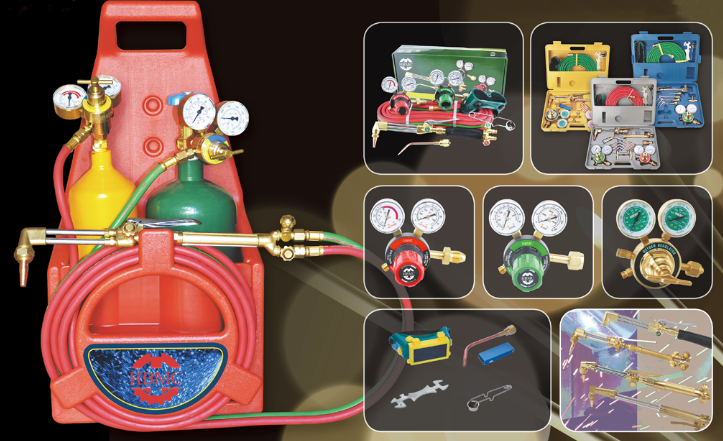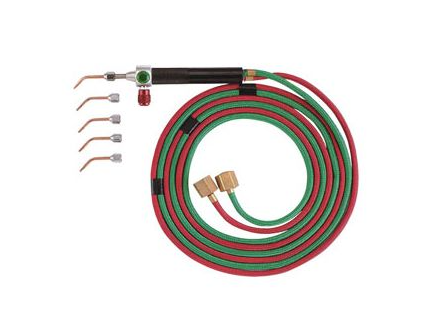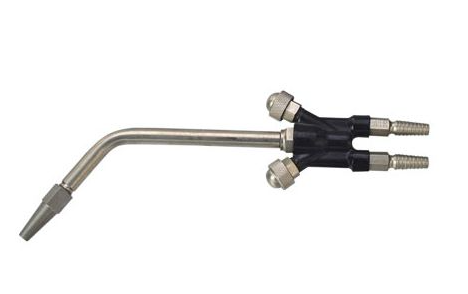Whether you're a professional welder or a DIY enthusiast, a cutting torch is an essential tool for various metalworking projects. Choosing the right cutting torch and accessories is crucial for achieving clean, precise cuts and ensuring safety during operation. This comprehensive guide will help you make an informed decision when purchasing a cutting torch and its accompanying components.
1. Determine Your Cutting Needs
Before you begin your search for a cutting torch, assess your specific cutting requirements. Consider factors such as the type and thickness of materials you'll be cutting, the frequency of use, and the working environment. This information will guide you in selecting the appropriate torch and accessories.
2. Types of Cutting Torches
There are several types of cutting torches available, including:
**Oxy-Fuel Cutting Torch:** Ideal for cutting ferrous metals, it uses a combination of oxygen and a fuel gas, such as acetylene or propane, to create a high-temperature flame.
**Plasma Cutting Torch:** Suitable for cutting a wide range of metals, plasma torches use a high-velocity stream of ionized gas to melt and remove the metal.
**Fuel Gas Cutting Torch:** These torches use gases like acetylene, propane, or natural gas for cutting. They are versatile and can handle various materials and thicknesses.
Choose the type of cutting torch that best matches your cutting needs and the materials you work with most frequently.

Cutting Torch and Accessories
3. Cutting Torch Features
When selecting a cutting torch, pay attention to the following features:
**Cutting Capacity:** Different torches have varying cutting capabilities, so ensure that the torch you choose can handle the thickness of the materials you work with.
**Cutting Speed:** Consider the cutting speed, as it can affect your efficiency and project completion time.
**Ergonomics:** Look for torches with comfortable grips and controls to minimize operator fatigue during extended use.
**Torch Length:** Longer torches provide better reach, which can be advantageous in certain cutting scenarios.
4. Choose the Right Fuel Gas
If you opt for an oxy-fuel cutting torch, select the appropriate fuel gas. Acetylene, propane, and natural gas are common choices. The type of fuel gas you use can impact the cutting efficiency and the quality of the cut. Ensure that your torch is compatible with your chosen gas and that you have the necessary regulators and hoses.

Jewelry Little Welding Torch
5. Safety First
Ensure that your cutting torch setup includes safety features like flashback arrestors, pressure regulators, and check valves. Safety should be a top priority, so invest in quality safety equipment, such as protective clothing, gloves, and goggles, to shield yourself from heat, sparks, and potentially harmful fumes.
6. Consider Consumables and Accessories
Aside from the cutting torch itself, there are essential accessories and consumables to consider:
**Cutting Tips:** Different tips are available for various cutting applications and material thicknesses. Make sure you have the right ones for your needs.
**Hoses:** High-quality hoses are necessary for safe gas flow. Ensure they are in good condition and free from damage or wear.
**Cylinders:** If you're using gas cylinders, ensure they are properly maintained, secured, and equipped with appropriate regulators.
**Cutting Guides:** Cutting guides and straightedges help you achieve accurate and precise cuts.
7. Brand Reputation and Reviews
Research the reputation of cutting torch brands and read user reviews to gain insights into the performance and durability of specific torch models. Established brands with a history of quality products are often a safer choice.

British Type Welding Torch
8. Budget Considerations
Set a budget for your cutting torch and accessories. Prices can vary widely based on the type of torch and the included features. Consider your budget while balancing the quality and functionality you require for your projects.
FAQs: Answering Your Cutting Torch Questions
1. What is the difference between oxy-fuel and plasma cutting torches?
Oxy-fuel torches use a combination of oxygen and a fuel gas for cutting, while plasma torches use ionized gas to cut through metal. Oxy-fuel is ideal for ferrous metals, while plasma can cut a wider range of materials.
2. What are flashback arrestors, and why are they important?
Flashback arrestors are safety devices that prevent flames from traveling back into the hoses and gas cylinders. They are crucial for preventing accidents and should be used with cutting torches.
3. How can I maintain my cutting torch for optimal performance?
Maintaining your cutting torch includes regularly cleaning the tip, checking for leaks in hoses, and replacing damaged or worn parts. Follow the manufacturer's maintenance guidelines for your specific torch model.
4. Can I use one cutting torch for all materials and thicknesses?
The suitability of a cutting torch for different materials and thicknesses depends on the torch type and cutting capacity. While some torches are versatile, it's essential to choose a torch that matches your specific cutting needs for the best results.
By following this comprehensive guide and considering your cutting requirements, safety, and budget, you'll be well-prepared to select the right cutting torch and accessories for your metalworking projects. Whether you're a professional or a hobbyist, the right tools will make a significant difference in the quality and efficiency of your work.
If you are interested in cutting torch and accessories, you can contact us and we will be happy to help you.










